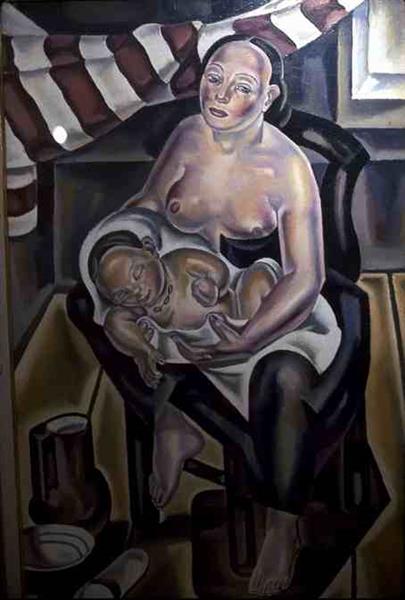Description
The work "Maternity" of 1928, by Maria Blanchard, is a significant example of the unique approach that the Spanish painter contributed to the cubist movement, which was one of the most prominent voices. Blanchard, born in 1881 in the city of Santurce, has been recognized for his ability to merge the geometry of Cubism with a deep sensitivity towards the issues of motherhood, intimacy and everyday life.
In this work, the composition reveals a clearly orderly structure that characterizes Blanchard's work. The central figure, which symbolizes motherhood, is represented in a powerful and at the same time subtle way, highlighting the figure of the mother who holds her son in a way that suggests both tenderness and strength. The interaction between the mother and the child is expressed through a series of angular forms and gently curved contours. This contrast between the stiffness of the lines and the fluidity of the curves highlights the tension inherent in the act of being a mother: strong protection together with an exposed vulnerability.
Color is another fundamental aspect in this work. Blanchard chooses a palette that ranges between warm terrible tones and colder nuances, which not only establishes an emotional connection, but also allows the figures to integrate harmoniously into the pictorial space. The colors complement the composition and, at the same time, reflect the emotional complexity that is associated with motherhood. The way in which tones merge and juxtapose suggests an atmosphere of calm and reflection, transforming the scene into an almost intimate and personal environment.
In addition, it is interesting to notice Blanchard's ability to sublimize the human figure in a cubist context. Through its use of cubist language, it manages to decompose and recompose the forms, allowing the work to climb towards a more symbolic and less literal dimension. Blanchard's approach not only stops in the representation of the mother and the child, but invites the viewer to explore the multiple facets and meanings of motherhood in a social and cultural context.
Maria Blanchard is part of a generation of artists who, in her search for new forms of expression, challenged the aesthetic conventions of her time. In "maternity", we see not only a testimony of family life, but also a reflection on the role of women in the society of their time. The work is in a period where cubist painting was evolving, and Blanchard stands out for different reasons, including its focus on deeply human issues and its ability to integrate cubist aesthetics with a rich emotional narrative.
This work, although not as known as some of the great pieces of Cubism, resonates with a sincerity that transcends its time and form. Through "maternity", Maria Blanchard invites us to perceive the complexity of the relationship between mother and son, and to contemplate the essence of the act of caring and nourishing in a world often stripped of these essential qualities. His legacy as an artist and pioneer continues to influence the way we perceive and represent the female experience in contemporary art.
KUADROS ©, a famous paint on your wall.
Hand-made oil painting reproductions, with the quality of professional artists and the distinctive seal of KUADROS ©.
Art reproduction service with satisfaction guarantee. If you are not completely satisfied with the replica of your painting, we refund your money 100%.

